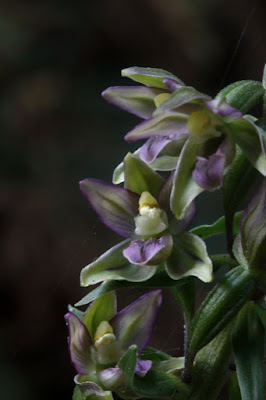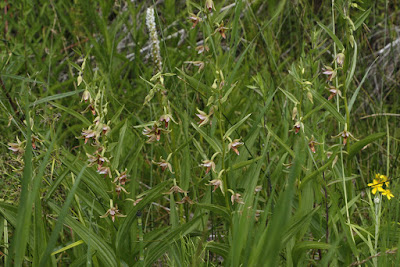A photographic record of the beautiful and often rare native orchids that can be found in our area.
Tuesday, September 6, 2016
The End of Another Season
Our 2016 native orchid season was considerably abbreviated by a trip to Australia, so we saw only a limited number of the species we usually visit and did not accomplish much of what we had intended for the season. The high point was finding in Washington a species we had seen elsewhere but not in the state, Listera or Neottia borealis, the Northern Twayblade. True to its name we found it in the northernmost parts of the state.
We also looked for and found again some rarities, particularly the natural hybrid of the two varieties of Fairy Slippers, the Eastern and Western Fairy Slippers, Kostiuk's Hybrid Fairy Slipper, Calypso bulbosa x kostiukiae, and the white form of the Western Fairy Slipper, Calypso bulbosa var. occidentalis fma. nivea. Both of these were growing where we had found them previously and seemed well established in those locations.
We found some new sites for the Western Fairy Slipper and for the Early Coralroot, Corallorhiza trifida, the latter especially important since it is not common in the state of Washington. These sites were on both sides of the Cascades and proof that the species is adaptable and quite widely distributed, though it is here near the southern end of its range, being much more common as one moves to the north.
We missed a lot of species, however, and will have to look for some of them next year. As always are plans are to look for new locations and to find in the state of Washington the species we have not yet seen there, especially Dactylorhiza viride var. virescens, the Long-bracted Green Orchis, and Platanthera obtusata var. obtusata, the Blunt-leaved Rein Orchis, and we have locations for both within the state.
Monday, August 8, 2016
An Alien Species in Larrabee State Park
Friday, August 5, I visited Larrabee State Park south of Bellingham to see how the Broad-leaved Helleborines were doing. Due, I suspect, to the dry summer we've had some were already finished and others were just starting to bloom and in one location there were very few to found, though they are usually abundant in that location. Epipactis is not a New World native but comes from Europe. It has, however, established itself across the USA and Canada. Here are the photos I was able to take.
Monday, August 1, 2016
Three Piperias and a Goodyera at Deception Pass
Saturday, July 30, I was down on Whidbey Island at Deception Pass State Park to look for several orchids there. I found three Platantheras (formerly Piperias) and one Goodyera in bloom. Goodyera oblongifolia, the Giant Rattlesnake Orchis, was just starting to bloom. The three Platantheras were at different stages of their bloom seasons. Platanthera elegans, the Elegant Piperia, was nearly finished. Platanthera transversa, the Flat-spurred Piperia, was still good but past its prime, and Plaatanthera elongata, the Long-spurred Piperia was at the peak of its bloom. The latter species was also more abundant than usual, with hundreds of plants and several large colonies. It should be noted that all the Piperias are now reclassified as Platantheras, though I prefer the old names since they are so distinctive.
Giant Rattlesnake Orchis
Goodyera oblongifolia
Elegant Piperia
Platanthera elegans
Flat-spurred Piperia
Platanthera transversa
Long-spurred Piperia
Platanthera elongata
Thursday, July 14, 2016
Long-spurred Piperia near Pend Oreille
While at a youth camp near Pend Oreille on the Washington Idaho border, I hiked into the hills back of the camp and found a number of Long-spurred Piperia (Platanthera elongata) in bloom. This rather common species has recently been renamed - it was Piperia elongata, but I prefer the older name since the Piperias are very distinctive.
Wednesday, July 6, 2016
Four Orchids in Sherman Pass
Traveling to eastern Washington, I did some hiking in the area of Sherman Pass in Colville National Forest. I was looking for the Northern Twayblade, Neottia borealis, a plant I had seen many times in the Canadian Rockies and never here in Washington. Using GPS coordinates given me by a friend, I found it at the peak of its bloom right along the trail, about a dozen plants and growing with it, the Early Coralroot, Corallorhiza trifida, though that was very nearly finished blooming. Later, continuing my trip, I stopped along the road to photograph a large colony of the Stream Orchid, Epipactis gigantea, and some Sierra Rein Orchis, Platanthera dilatata var. leucostachys, growing with them. The star of the show, though, was the Listera, a first for me in Washington.
Northern Twayblade
Neottia borealis
Early Coralroot
Corallorhiza trifida
Stream Orchid
Epipactis gigantea
Sierra Rein Orchis
Subscribe to:
Posts (Atom)










































































